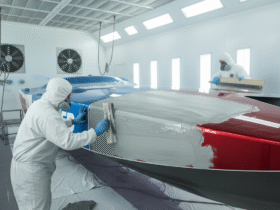Industrial fans are essential components in various industries, serving functions from ventilation to cooling and air circulation. Given their pivotal role, ensuring their longevity is crucial for maintaining efficient operations and avoiding costly downtime. Extending the lifespan of industrial fans involves a combination of proactive maintenance, thoughtful operation, and timely upgrades. In this blog, we’ll explore practical tips and tricks for maximizing the lifespan of your industrial fans.
Understanding Industrial Fans
Industrial fans are robust machines designed to handle high volumes of air and operate in challenging environments. They come in various types, including axial fans, centrifugal fans, and inline fans, each suited to specific applications. Common applications include:
- Ventilation Systems: To provide fresh air and remove contaminants.
- Cooling Systems: To dissipate heat from machinery or processes.
- Dust Collection Systems: To move air and particles away from work areas.
Given their heavy-duty usage, industrial fans are subject to wear and tear. Proper care can significantly impact their efficiency and operational lifespan.
Tips for Extending the Lifespan of Industrial Fans
1. Regular Inspection and Maintenance
Routine inspection and maintenance are crucial for identifying issues before they lead to significant problems. Regularly check the following:
- Blades and Impellers: Inspect for signs of damage, wear, or imbalance. Damaged blades can lead to reduced efficiency and additional stress on the motor.
- Bearings: Check for unusual noises or vibrations that could indicate bearing wear. Proper lubrication and timely replacement can prevent premature failure.
- Motor: Ensure the motor is free from dust and debris, and check for signs of overheating or electrical issues.
Maintenance Schedule: Implement a maintenance schedule based on the manufacturer’s recommendations and the fan’s operating conditions. Regular checks can help in catching issues early and extending the fan’s operational life.
2. Proper Lubrication
Lubrication is vital for reducing friction and wear on moving parts. Follow these guidelines:
- Use the Correct Lubricant: Refer to the manufacturer’s specifications for the type and grade of lubricant required.
- Apply Lubricant Properly: Avoid over-lubricating, which can lead to contamination and other issues. Follow recommended lubrication intervals and amounts.
- Monitor Lubricant Condition: Regularly check the condition of the lubricant and replace it if it becomes contaminated or degraded.
Automated Lubrication Systems: Consider installing automated lubrication systems to ensure consistent application and reduce manual maintenance efforts.
3. Balancing and Alignment
Proper balancing and alignment are essential for smooth fan operation and reduced wear:
- Check for Imbalance: Imbalance in the fan blades can cause excessive vibration and stress on the motor and bearings. Use balancing tools to ensure the fan is properly balanced.
- Ensure Proper Alignment: Misalignment between the fan and motor can lead to increased wear and potential failure. Regularly check and adjust alignment as needed.
Professional Balancing: If necessary, hire a professional to balance and align the fan properly, especially if it operates at high speeds or in critical applications.
4. Cleaning and Debris Removal
Dust and debris can accumulate in and around industrial fans, affecting their performance and lifespan:
- Regular Cleaning: Implement a cleaning schedule to remove dust, dirt, and other contaminants from the fan blades, housing, and motor. This prevents clogging and maintains efficient airflow.
- Protective Screens: Install protective screens or filters to reduce the amount of debris entering the fan. Ensure these are cleaned or replaced regularly.
Airflow Management: Ensure that the area around the fan is clear of obstructions that could impede airflow and cause overheating.
5. Temperature Control
Overheating can significantly impact the lifespan of industrial fans:
- Monitor Operating Temperature: Ensure that the fan operates within its designed temperature range. Excessive heat can lead to motor damage and other issues.
- Improve Ventilation: Enhance the cooling of the fan and surrounding areas by improving ventilation or adding cooling systems if necessary.
Thermal Protection: Consider installing thermal protection devices or sensors to monitor and manage temperature effectively.
6. Vibration Monitoring
Vibrations can indicate underlying problems and lead to premature wear if not addressed:
- Use Vibration Sensors: Install vibration sensors to monitor the fan’s condition and detect abnormal vibrations early.
- Analyze Vibration Data: Regularly review vibration data to identify trends or potential issues. Address any abnormal vibrations promptly to prevent further damage.
Balancing and Maintenance: Address any issues identified through vibration monitoring, such as imbalanced blades or misaligned components.
7. Operational Best Practices
How the fan is used and operated can impact its lifespan:
- Avoid Overloading: Ensure the fan is not subjected to loads beyond its designed capacity. Overloading can cause excessive stress and wear.
- Gradual Start-Up: Use soft start mechanisms to gradually bring the fan up to speed, reducing the strain on components during start-up.
- Regular Operation: Operate the fan within its intended parameters to avoid undue stress and maintain efficiency.
Training: Train staff on proper operating procedures and best practices to ensure the fan is used correctly and maintained effectively.
8. Upgrade Components
As technology advances, upgrading components can improve performance and extend the lifespan of your fan:
- Energy-Efficient Motors: Consider upgrading to energy-efficient motors that offer better performance and reduced wear.
- Advanced Controls: Implement advanced control systems that provide better management and monitoring of the fan’s operation.
Consult with Experts: Work with manufacturers or industry experts to identify and implement suitable upgrades for your specific application.
Conclusion
Extending the lifespan of industrial fans requires a comprehensive approach that combines regular maintenance, proper operation, and timely upgrades. By following these tips and tricks, you can ensure that your industrial fans operate efficiently and reliably, minimizing downtime and reducing maintenance costs.
Implementing a proactive maintenance strategy, monitoring performance, and addressing issues promptly will help you get the most out of your industrial fans. Embrace these best practices to enhance the longevity and efficiency of your fan systems, contributing to the overall success and sustainability of your operations.










Find Us on Socials